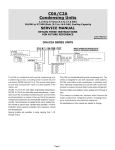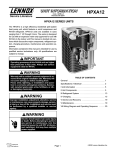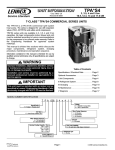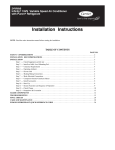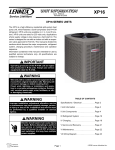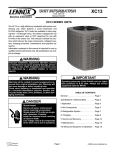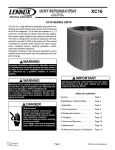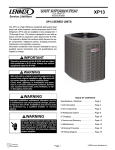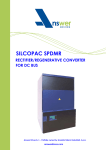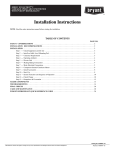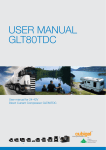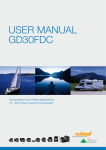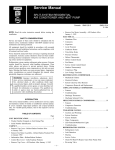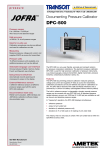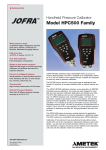Download 10ACC Series - HvacPartsShop.com
Transcript
10ACC Corp. 0201−L1 Revised 08−2004 Service Literature 10ACC SERIES UNITS The 10ACC is a residential split-system condensing unit available in sizes ranging from 1−1/2 to 5 tons. Condensing coil size, circuiting and air volume result in a minimum SEER rating of 10.0. The series is designed for use with an expansion valve or RFCIV system in the indoor unit. 10ACC units are equipped with either a reciprocating compressor or scroll compressor. All compressors are hermetically sealed for long service life. The compressor is installed in the unit on resilient rubber mounts to assure quiet, vibration-free operation. A built-in protection device assures protection from excessive current and temperatures. The scroll operates like a standard compressor but it is unique in the way it compresses refrigerant. This manual is divided into sections which discuss the major components, refrigerant system, charging procedure, maintenance and operation sequence. All specifications in this manual are subject to change. WARNING Electric shock hazard. Can cause injury or death. Before attempting to perform any service or maintenance, turn the electrical power to unit OFF at disconnect switch(es). Unit may have multiple power supplies. TABLE OF CONTENTS IMPORTANT Improper installation, adjustment, alteration, service or maintenance can cause property damage, personal injury or loss of life. Installation and service must be performed by a qualified installer or service agency. Electrical Data and Specifications . . . . . . . . . . . . . . . . 2 I General . . . . . . . . . . . . . . . . . . . . . . . . . . . . . . . . . . . . . 3 II Unit Components . . . . . . . . . . . . . . . . . . . . . . . . . . . . . 3 III Refrigerant System . . . . . . . . . . . . . . . . . . . . . . . . . . 6 IV Charging . . . . . . . . . . . . . . . . . . . . . . . . . . . . . . . . . . . 8 V Maintenance . . . . . . . . . . . . . . . . . . . . . . . . . . . . . . . . 11 IMPORTANT The Clean Air Act of 1990 bans the intentional venting of (CFC’s and HFC’s) as of July 1, 1992. Approved methods of recovery, recycling or reclaiming must be followed. Fines and/or incarceration my be levied for noncompliance. VI Wiring Diagram . . . . . . . . . . . . . . . . . . . . . . . . . . . . . 12 WARNING Refrigerant can be harmful if it is inhaled. Refrigerant must be used and recovered responsibly. Failure to follow this warning may result in personal injury or death. Page 1 © 2002 Lennox Industries Inc. Litho U.S.A. ELECTRICAL DATA General Data Compressor Condenser Fan Motor Model No. 10ACC−018 10ACC−024 10ACC−024 10ACC−030 10ACC−030 10ACC−036 10ACC−042 10ACC−048 10ACC−060 −230 −230−01 −230−02 −230−01 −230−03 −230 −230 −230 −230 Line voltage data − 60hz 208/230v 1ph 208/230v 1ph 208/230v 1ph 208/230v 1ph 208/230v 1ph 208/230v 1ph 208/230v 1ph 208/230v 1ph 208/230v 1ph Rec. max fuse size (amps) 20 25 25 30 30 35 40 50 60 Minimum circuit ampacity 11.6 14.3 16.1 17.3 18.4 20.4 23 31.2 35.2 Rated load amps 8.6 10.8 12.2 12.9 14.1 16.2 17.9 21.8 26.6 Locked rotor amps 49.0 60 61 69.4 73.0 96 103 131 170 Power factor 0.97 0.96 0.96 0.92 0.95 0.90 0.84 0.80 0.90 Full load amps 0.8 0.8 0.8 1.1 .0.8 1.7 1.9 1.9 0.9 Locked rotor amps 1.2 1.2 1.2 1.9 1.2 3.1 4.1 4.1 4.1 Refer to National or Canadian Electrical Code manual to determine wire, fuse and disconnect size requirements. NOTE Extremes of operating range are plus 10% and minus 5% of line voltage. SPECIFICATIONS General D t Data Connections ( (sweat) t) Refrigerant Model No. Nominal Tonnage (kW) Liquid line (o.d.) − in. (mm) Suction line (o.d.) − in. (mm) *HCFC−22 charge furnished Net face area − sq. ft. (m2) Outer Coil Inner Coil Tube diameter − in. (mm) No. of rows Fins per inch (m) Diameter − in. (mm) Condenser F Fan No. of blades Motor hp (W) Cfm (L/s) Rpm Watts Shipping weight (1 package) lbs. (kg) Condenser C il Coil 10ACC−018 1.5 (5.3) 3/8 (9.5) 5/8 (15.9) 3lbs. 7 oz. (1.56 kg) 10.0 (0.93) −−− 5/16 (7.9) 1 18 (709) 16 (406) 3 1/10 (75) 1730 (815) 1070 184 126 (57) 10ACC−024 2 (7.0) 3/8 (9.5) 3/4 (19.1) 3 lbs. 9 oz. (1.62 kg) 10.0 (0.93) −−− 5/16 (7.9) 1 18 (709) 16 (406) 3 1/10 (75) 1730 (815) 1070 184 107 (49) 10ACC−030 2.5 (8.8) 3/8 (9.5) 3/4 (19.1) 3 lbs. 10 oz. (1.64 kg) 10.0 (0.93) −−− 5/16 (7.9) 1 18 (709) 18 (457) 3 1/10 (75) 1730 (815) 1070 184 107 (49) 68887 17L71 24H77 90P12 17L71 24H77 90P12 17L71 24H77 94J45 64J09 94J45 10J42 10ACC−036 3 (10.6) 3/8 (9.5) 3/4 (19.1) 4 lbs. 10 oz. (2.12 kg) 11.41 (1.06) −−− 5/16 (7.9) 1 22 (866) 18 (457) 3 1/4 (187) 2510 (1185) 1103 266 140 (64) 10ACC−042 3.5 (12.3) 3/8 (9.5) 7/8 (22.2) 5 lbs. 1 oz. (2.28 kg) 13.31 (1.24) −−− 5/16 (7.9) 1 22 (866) 18 (457) 4 1/3 (249) 2800 (1320) 1116 299 140 (64) 10ACC−048 4 (14.1) 3/8 (9.5) 7/8 (22.2) 6 lbs. 0 oz. (2.72 kg) 15.11 (1.40) 5.4 (0.50) 5/16 (7.9) 1.37 22 (866) 18 (457) 4 1/3 (249) 2950 (1390) 1100 310 196 (89) 10ACC−060 5 (17.6) 3/8 (9.5) 1−1/8 (28.6) 8 lbs. 2 oz. (3.67 kg) 20.83 (1.94) −−− 5/16 (7.9) 1 22 (866) 22 (559) 4 1/3 (249) 3900 (1840) 1100 367 199 (90) 90P12 17L73 24H77 90P12 17L73 24H77 94J45 81J69 94J45 81J69 OPTIONAL ACCESSORIES - MUST BE ORDERED EXTRA Crankcase Heater Hail Guards Low Ambient Kit (for Expansion Valve systems only) Mounting g Model No. B Base Net Weight Dimensions − in. (mm) Timed−Off Control Unit Stand−Off Kit Unit Hard−Start Kit Compressor Monitor (Canada only) 68887 90P12 17L73 17L73 24H77 24H77 MB2−S (69J06) 6 lbs. (3 kg) 22−1/4x22−1/4x3 (565 x 565x76) LB−61378A (47J35) 94J45 94J45 94J45 10J42 64J09 81J69 T6−1469 (45F08) *Refrigerant charge sufficient for 15 ft. (4.5 m) length of refrigerant lines. 3/8 in. x 5/16 in. (9.5 mm x 7.9 mm) reducer bushing (not furnished) is required for liquid line connection. Page 2 I − GENERAL 10ACC UNIT CONTROL BOX RECIPROCATING COMPRESSOR DANGER DUAL CAPACITOR (C12) START CAPACITOR (C7) (option only) Make sure all power is disconnected before beginning electrical service procedures. 10ACC condensing units are available in 1 -1/2, 2, 2 -1/2, 3, 3 -1/2, 4 and 5 ton capacities. All major components (indoor blower and coil) must be matched according to Lennox recommendations for the compressor to be covered under warranty. Refer to the Engineering Handbook for approved system matchups. A misapplied system will cause erratic operation and can result in early compressor failure. COMPRESSOR CONTACTOR (K1) POTENTIAL RELAY (K31) (option only) GROUNDING LUG II − UNIT COMPONENTS Unit components are illustrated in figure 1. FIGURE 2 10ACC UNIT COMPONENTS OUTDOOR FAN/MOTOR CONTROL BOX 10ACC UNIT CONTROL BOX Scroll Compressor DUAL CAPACITOR (C12) DISCHARGE LINE COMPRESSOR CONTACTOR (K1) SUCTION LINE SERVICE VALVE COMPRESSOR GROUNDING LUG LIQUID LINE SERVICE VALVE SUCTION LINE FIGURE 3 FIGURE 1 Page 3 A − Control Box (Figures 2 & 3) 2 − Dual Capacitor C12 Electrical openings are provided under the control box cover. Field thermostat wiring is made to color-coded pigtail connections. The compressor and fan in 10ACC series units use permanent split capacitor motors. The capacitor is located inside the unit control box (see figures 2 and 3). A single dual" capacitor (C12) is used for both the fan motor and the compressor (see unit wiring diagram). The fan side and the compressor side of the capacitor have different MFD ratings. For ratings see side of capacitor. 1 − Compressor Contactor K1 The compressor is energized by a contactor located in the control box. See figure 2. Single−pole contactors are used in 10ACC units. K1 is energized by the indoor thermostat terminal Y1 (24V) when thermostat demand is present. 10ACC units are not equipped with a 24V transformer. All 24 VAC controls are powered by the indoor unit. Refer to wiring diagram. DANGER Electric Shock Hazard. May cause injury or death. Line voltage is present at all components when unit is not in operation on units with single pole contactors. Disconnect all remote electrical power supplies before opening unit panel. Unit may have multiple power supplies. 3 − Start Capacitor C7 (option) Start capacitor (C7) is wired in parallel with the compressor side of the dual capacitor. The capacitor is located inside the unit control box (see figure 2). C7 is switched off by potential relay (K31) when the compressor nears full speed.The start capacitor is rated at 330 VAC and has an MFD rating of 176−216. 4 − Potential (Start) Relay K31 (option) Potential relay K31 is located inside the unit control box (see figure 2). The relay is normally closed when contactor K1 is de-energized. When K1 energizes, the compressor immediately begins start-up. K31 remains closed during compressor start-up and the start capacitor C7 remains in the circuit. When the compressor reaches 75% of its speed, K31 is energized. When K31 energizes, the contacts open and the start capacitor C7 is taken out of the circuit. Page 4 B − Compressor CROSS−SECTION OF SCROLLS For compressor specifications see ELECTRICAL DATA" section in this manual or the compressor nameplate. DISCHARGE STATIONARY SCROLL DISCHARGE PRESSURE SCROLL COMPRESSOR SUCTION DISCHARGE ORBITING SCROLL SUCTION TIPS SEALED BY DISCHARGE PRESSURE FIGURE 6 FIGURE 4 1 − Scroll Compressor The scroll compressor design is simple, efficient and requires few moving parts. A cutaway diagram of the scroll compressor is shown in figure 4.The scrolls are located in the top of the compressor can and the motor is located just below. The oil level is immediately below the motor. The scroll is a simple compression concept centered around the unique spiral shape of the scroll and its inherent properties. Figure 5 shows the basic scroll form. Two identical scrolls are mated together forming concentric spiral shapes (figure 6 ). One scroll remains stationary, while the other is allowed to orbit" (figure 7). Note that the orbiting scroll does not rotate or turn but merely orbits" the stationary scroll. SCROLL FORM FIGURE 5 Page 5 The counterclockwise orbiting scroll draws gas into the outer crescent shaped gas pocket created by the two scrolls (figure 7 − 1). The centrifugal action of the orbiting scroll seals off the flanks of the scrolls (figure 7 − 2). As the orbiting motion continues, the gas is forced toward the center of the scroll and the gas pocket becomes compressed (figure 7 − 3). When the compressed gas reaches the center, it is discharged vertically into a chamber and discharge port in the top of the compressor (figure 6). The discharge pressure forcing down on the top scroll helps seal off the upper and lower edges (tips) of the scrolls (figure 6 ). During a single orbit, several pockets of gas are compressed simultaneously providing smooth continuous compression. The scroll compressor is tolerant to the effects of liquid return. If liquid enters the scrolls, the orbiting scroll is allowed to separate from the stationary scroll. The liquid is worked toward the center of the scroll and is discharged. If the compressor is replaced, conventional Lennox cleanup practices must be used. Due to its efficiency, the scroll compressor is capable of drawing a much deeper vacuum than reciprocating compressors. Deep vacuum operation can cause internal fusite arcing resulting in damaged internal parts and will result in compressor failure. Never use a scroll compressor for evacuating or pumping−down" the system. This type of damage can be detected and will result in denial of warranty claims. NOTE − During operation, the head of a scroll compressor may be hot since it is in constant contact with discharge gas. HOW A SCROLL WORKS SUCTION MOVEMENT OF ORBIT SUCTION INTERMEDIATE PRESSURE GAS CRESCENT SHAPED GAS POCKET ORBITING SCROLL SUCTION POCKET 2 1 FLANKS SEALED BY CENTRIFUGAL FORCE STATIONARY SCROLL SUCTION SUCTION 3 4 HIGH PRESSURE GAS DISCHARGE POCKET FIGURE 7 C − Condenser Fan Motor All units use single−phase PSC fan motors which require a run capacitor. In all units, the condenser fan is controlled by the compressor contactor. ELECTRICAL DATA tables in this manual show specifications for condenser fans used in 10ACCs. Access to the condenser fan motor on all units is gained by removing the seven screws securing the fan assembly. See figure 8. The condenser fan motor is removed from the fan guard by removing the four nuts found on the top panel. See figure 9 if condenser fan motor replacement is necessary. CONDENSER FAN MOTOR AND COMPRESSOR ACCESS FAN GUARD Remove (7) screws ALIGN FAN HUB FLUSH WITH END OF SHAFT FIGURE 9 III − REFRIGERANT SYSTEM A − Plumbing Field refrigerant piping consists of liquid and suction lines from the condensing unit (sweat connections) to the indoor evaporator coil (flare or sweat connections). Use Lennox L15 (sweat, non−flare) series line sets as shown in table 1 or use field−fabricated refrigerant lines. Separate discharge and suction service ports are provided outside the unit for connection of gauge manifold during charging procedure. TABLE 1 FAN MOTOR WIRING RACEWAY Remove (4) nuts REMOVE (7) SCREWS SECURING FAN GUARD. REMOVE FAN GUARD/FAN ASSEMBLY. FIGURE 8 Model Liquid Line Vapor Line L15 Line Sets 10ACC−018 5/16 in* (8 mm) 5/8 in (16 mm) 10ACC−024 10ACC−030 10ACC−036 3/8 in (10 mm) 3/4 in. (19 mm) L15−21 15 ft.− 50 ft. (4.5m − 15m) L15−41 15 ft.− 50 ft. (4.5m − 15m) 10ACC−042 10ACC−048 3/8 in (10 mm) 7/8 in. (22 mm) L15−65 15 ft.− 50 ft. (4.5m − 15m) 10ACC−060 3/8 in (10 mm) 1−1/8 in. (29 mm) Field Fabricated *Field fabricate. See Corp. 9351−L9 Refrigerant Piping Page 6 B − Service Valves The liquid and vapor line service valves (figures 10 and 11) and gauge ports are accessible from outside the unit. The valve is equipped with a service port. The service ports are used for leak testing, evacuating, charging and checking charge. A schrader valve is factory installed. A service port cap is supplied to protect the schrader valve from contamination and serve as the primary leak seal. NOTE-Always keep valve stem caps clean. To Access Schrader Port: Service Valve (Valve Closed) stem cap service port insert hex wrench here to outdoor coil service port cap 1 − Remove service port cap with an adjustable wrench. 2 − Connect gauge to the service port. 3 − When testing is completed, replace service port cap. Tighten finger tight, then an additional 1/6 turn. (valve front seated) To Open Liquid or Vapor Line Service Valve: 1 − Remove stem cap with an adjustable wrench. 2 − Using service wrench and hex head extension (3/16 for liquid line and 5/16 for vapor line) back the stem out counterclockwise until the valve stem just touches the retaining ring. 3 − Replace stem cap tighten firmly. Tighten finger tight, then tighten an additional 1/6 turn. to indoor coil Schrader valve open to line set when valve is closed (front seated) insert hex wrench here Service Valve (Valve Open) stem cap service port to outdoor coil To Close Liquid or Vapor Line Service Valve: 1 − Remove stem cap with an adjustable wrench. 2 − Using service wrench and hex head extension (3/16 for liquid line and 5/16 for vapor line), turn stem clockwise to seat the valve. Tighten firmly. 3 − Replace stem cap. Tighten finger tight, then tighten an additional 1/6 turn. Vapor Line (Ball Type) Service Valve (5 Ton Only) A ball-type full service valve is used on 10ACC 5 ton units. These suction line service valves function the same way, differences are in construction. Valves are not rebuildable. If a valve has failed it must be replaced. A ball valve is illustrated in figure 11. service port cap to indoor coil Schrader valve FIGURE 10 SUCTION LINE (BALL TYPE) SERVICE VALVE (VALVE OPEN) USE ADJUSTABLE WRENCH ROTATE STEM CLOCKWISE 90 TO CLOSE ROTATE STEM COUNTER-CLOCKWISE 90 TO OPEN STEM CAP INLET (FROM INDOOR COIL) The ball valve is equipped with a service port. A schrader valve is factory installed. A service port cap is supplied to protect the schrader valve from contamination and assure a leak free seal. STEM BALL (SHOWN OPEN) OUTLET (TO COMPRESSOR) SERVICE PORT CAP SERVICE PORT SCHRADER CORE FIGURE 11 Page 7 IV − CHARGING A − Pumping Down System CAUTION Deep vacuum operation (operating compressor at 0 psig or lower) can cause internal fusite arcing resulting in a damaged or failed compressor. This type of damage will result in denial of warranty claim. The system may be pumped down when leak checking the line set and indoor coil or making repairs to the line set or indoor coil. 1− Attach gauge manifold. 2− Front seat (close) liquid line valve. 3− Start outdoor unit. 4− Monitor suction gauge. Stop unit when 0 psig is reached. 5− Front seat (close) suction line valve. B − Leak Testing (To Be Done Before Evacuating) After the line set has been connected to the indoor and outdoor units, check the line set connections and indoor unit for leaks. WARNING Refrigerant can be harmful if it is inhaled. Refrigerant must be used and recovered responsibly. Failure to follow this warning may result in personal injury or death. WARNING Danger of explosion: Can cause equipment damage, injury or death. Never use oxygen to pressurize a refrigeration or air conditioning system. Oxygen will explode on contact with oil and could cause personal injury. WARNING Danger of explosion: Can cause equipment damage, injury or death. When using a high pressure gas such as dry nitrogen to pressurize a refrigeration or air conditioning system, use a regulator that can control the pressure down to 1 or 2 psig (6.9 to 13.8 kPa). Using an Electronic Leak Detector or Halide 1 − Connect a cylinder of HCFC-22 to the center port of the manifold gauge set. 2 − With both manifold valves closed, open the valve on the HCFC-22 cylinder (vapor only). 3 − Open the high pressure side of the manifold to allow the HCFC-22 into the line set and indoor unit. Weigh in a trace amount of HCFC-22. [A trace amount is a maximum of 2 ounces (57 g) or 3 pounds (31 kPa) pressure.] Close the valve on the HCFC-22 cylinder and the valve on the high pressure side of the manifold gauge set. Disconnect the HCFC-22 cylinder. 4 − Connect a cylinder of nitrogen with a pressure regulating valve to the center port of the manifold gauge set. 5 − Connect the manifold gauge set high pressure hose to the vapor valve service port. (Normally, the high pressure hose is connected to the liquid line port; however, connecting it to the vapor port better protects the manifold gauge set from high pressure damage.) 6 − Adjust the nitrogen pressure to 150 psig (1034 kPa). Open the valve on the high side of the manifold gauge set which will pressurize line set and indoor unit. 7 − After a few minutes, open a refrigerant port to ensure the refrigerant you added is adequate to be detected. (Amounts of refrigerant will vary with line lengths.) Check all joints for leaks. Purge nitrogen and HCFC-22 mixture. Correct any leaks and recheck. C − Evacuating the System Evacuating the system of noncondensables is critical for proper operation of the unit. Noncondensables are defined as any gas that will not condense under temperatures and pressures present during operation of an air conditioning system. Noncondensables and water vapor combine with refrigerant to produce substances that corrode copper piping and compressor parts. NOTE − This evacuation process is adequate for a new installation with clean and dry lines. If excessive moisture is present, the evacuation process may be required more than once. IMPORTANT Use a thermocouple or thermistor electronic vacuum gauge that is calibrated in microns. Use an instrument that reads from 50 microns to at least 10,000 microns. 1 − Connect manifold gauge set to the service valve ports : low pressure gauge to vapor line service valve high pressure gauge to liquid line service valve 2 − Connect micron gauge. 3 − Connect the vacuum pump (with vacuum gauge) to the center port of the manifold gauge set. 4 − Open both manifold valves and start the vacuum pump. 5 − Evacuate the line set and indoor unit to an absolute pressure of 23,000 microns (29.01 inches of mercury). During the early stages of evacuation, it is desirable to close the manifold gauge valve at least once to determine if there is a rapid rise in absolute pressure. A rapid rise in pressure indicates a relatively large leak. If this occurs, repeat the leak testing procedure. Page 8 NOTE − The term absolute pressure means the total actual pressure within a given volume or system, above the absolute zero of pressure. Absolute pressure in a vacuum is equal to atmospheric pressure minus vacuum pressure. 6 − When the absolute pressure reaches 23,000 microns (29.01 inches of mercury), close the manifold gauge valves, turn off the vacuum pump and disconnect the manifold gauge center port hose from vacuum pump. Attach the manifold center port hose to a nitrogen cylinder with pressure regulator set to 150 psig (1034 kPa) and purge the hose. Open the manifold gauge valves to break the vacuum in the line set and indoor unit. Close the manifold gauge valves. CAUTION Danger of Equipment Damage. Avoid deep vacuum operation. Do not use compressors to evacuate a system. Extremely low vacuums can cause internal arcing and compressor failure. Damage caused by deep vacuum operation will void warranty. 7 − Shut off the nitrogen cylinder and remove the manifold gauge hose from the cylinder. Open the manifold gauge valves to release the nitrogen from the line set and indoor unit. 8 − Reconnect the manifold gauge to the vacuum pump, turn the pump on, and continue to evacuate the line set and indoor unit until the absolute pressure does not rise above 500 microns (29.9 inches of mercury) within a 20−minute period after shutting off the vacuum pump and closing the manifold gauge valves. 9 − When the absolute pressure requirement above has been met, disconnect the manifold hose from the vacuum pump and connect it to an upright cylinder of HCFC-22 refrigerant. Open the manifold gauge valves to break the vacuum from 1 to 2 psig positive pressure in the line set and indoor unit. Close manifold gauge valves and shut off the HCFC-22 cylinder and remove the manifold gauge set. D − Charging Units are factory charged with the amount of HCFC-22 refrigerant indicated on the unit nameplate. This charge is based on a matching indoor coil and outdoor coil with a 15 ft. (4.5 m) line set. For varying lengths of line set, refer to table 2 for refrigerant charge adjustment. A blank space is provided on the nameplate to list the actual field charge. Page 9 TABLE 2 Liquid Line Set Diameter Oz. per 5 ft. (g per 1.5 m) adjust from 15 ft. (4.5 m) line set* 3/8 in. (10 mm) 3 ounce per 5 ft. (85g per 1.5 m) *If line length is greater than 15 ft. (4.5 m), add this amount. If line length is less than 15 ft. (4.5 m), subtract this amount. The condensing unit should be charged during warm weather. However, applications arise in which charging must occur in the colder months. The method of charging is determined by the unit’s refrigerant metering device and the outdoor ambient temperature. Measure the liquid line temperature and the outdoor ambient temperature as outlined below: 1. −Connect the manifold gauge set to the service valves: low pressure gauge to suction valve service port; high pressure gauge to liquid valve service port. Connect the center manifold hose to an upright cylinder of HCFC-22. Close manifold gauge set valves. 2. −Set the room thermostat to call for heat. This will create the necessary load for properly charging the system in the cooling cycle. 3. −Use a digital thermometer to record the outdoor ambient temperature. 4. −When the heating demand has been satisfied, switch the thermostat to cooling mode with a set point of 68F (20C). When pressures have stabilized, use a digital thermometer to record the liquid line temperature. 5. −The outdoor temperature will determine which charging method to use. Proceed with the appropriate charging procedure. Weighing in the Charge Fixed Orifice or TXV Systems – Outdoor Temp < 60F (16C) If the system is void of refrigerant, or if the outdoor ambient temperature is cool, the refrigerant charge should be weighed into the unit according to the total amount shown on the unit nameplate. This may be done after any leaks have been repaired. If weighing facilities are not available or if unit is being charged during warm weather, follow one of the other procedures outlined below. 1 − Recover the refrigerant from the unit. 2 − Conduct a leak check, then evacuate as previously outlined. 3 − Weigh in the factory charge according to the amount recorded on the outdoor unit nameplate. Approach and Normal Operating Pressures TXV Systems – Outdoor Temp. > 65F (18C) The following procedure is intended as a general guide and is for use on expansion valve systems only. For best results, indoor temperature should be 70°F (21°C) to 80°F (26°C). Monitor system pressures while charging. 1 − Record outdoor ambient temperature using a digital thermometer. 2 − Attach high pressure gauge set and operate unit for several minutes to allow system pressures to stabilize. 3 − Compare stabilized pressures with those provided in table 5, Normal Operating Pressures." Minor variations in these pressures may be expected due to differences in installations. Significant differences could mean that the system is not properly charged or that a problem exists with some component in the system. Pressures higher than those listed indicate that the system is overcharged. Pressures lower than those listed indicate that the system is undercharged. Verify adjusted charge using the approach method. 4 − Outdoor temperature should be 65°F (18°C) or above. Use the same digital thermometer used to check outdoor ambient temperature to check liquid line temperature. Verify the unit charge using the approach method. The difference between the ambient and liquid temperatures should match values given in table 3. Refrigerant must be added to lower approach temperature and removed to increase approach temperature. Loss of charge results in low capacity and efficiency. 5 − If the values don’t agree with the those in table 3, add refrigerant to lower the approach temperature or recover refrigerant from the system to increase the approach temperature. Table 3 Charging Using the Subcooling Method Fixed Orifice Systems – Outdoor Temp. > 65F (18C) If you charge a fixed orifice system when the outdoor ambient is 65F (18C) or above, use the subcooling method to charge the unit. 1 − With the manifold gauge hose still on the liquid service port and the unit operating stably, use a digital thermometer to record the liquid line temperature. 2 − At the same time, record the liquid line pressure reading. 3 − Use a temperature/pressure chart for HCFC-22 to determine the saturation temperature for the liquid line pressure reading. 4 − Subtract the liquid line temperature from the saturation temperature (according to the chart) to determine subcooling. (Saturation temperature − Liquid line temperature = Subcooling) 5 − Compare the subcooling value with those in table 4. If subcooling is greater than shown, some refrigerant must be recovered. If subcooling is less than shown, some refrigerant must be added. Table 4 *F F (C) 118 218 LIQUID SUBCOOLING [+ 1F (.6C)] 24−2 24−1 30−1 30−3 36 42 Approach Temperature Liquid Line − Outdoor Ambient F (C) 48 60 Model No. 65 (18) 14 (8) 13 (7) 10 (5.6) 14 (8) 14 (8) 16 (9) 17 (9) 17 (9) 15 (8) 14 (8) 110ACC−018 7 (4) 70 (21) 13 (7) 13 (7) 9 (5) 14 (8) 14 (8) 15 (8.3) 17 (9) 17 (9) 14 (8) 15 (8) 210ACC−018 9 (5) 75 (24) 14 (8) 13 (7) 8 (4.5) 13 (7) 13 (7) 15 (8.3) 16 (9) 16 (9) 13 (7) 15 (8) 10ACC−024−01 9 (5) 10ACC−024−02 18 (10) 80 (27) 13 (7) 7 (3.9) 13 (7) 13 (7) 15 (8.3) 15 (8) 15 (8) 13 (7) 14 (8) 10ACC−030−01 12 (6.7) 85 (29) 13 (7) 6 (3.3) 12 (6.7) 13 (7) 14 (8) 14 (8) 14 (8) 12 (6) 14 (8) 10ACC−030−03 22 (12) 90 (32) 12 (7) 12 (6.7 ) 12 (6.7 ) 11 (6) 5 (2.8) 12 (6.7) 12 (6.7) 14 (8) 14 (8) 14 (8) 13 (7) 10ACC−036 11 (6) 95 (35) 11 (6) 4 (2.2) 11 (6) 11 (6) 13 (7) 12 (6) 14 (8) 10ACC−042 13 (7) 100 (38) 11 (6) 10 (5.6 ) 9 (5) 12 (6.7 ) 12 (6) 4 (2.2) 9 (5) 10 (5.6) 13 (7) 11 (6) 13 (7) 11 (6) 12 (7) 10ACC−048 8 (4.5) 105 (41) 10 (6) 3 (1.7) 8 (4.5) 9 (5) 12 (6.7) 10 (5) 12 (6) 10 (5) 12 (7) 10ACC−060 13 (7) 110 (43) 9 (5) 8 (4.5 ) 7 (4) 3 (1.7) 7 (4) 7 (4) 11 (6) 9 (5) 11 (6) 9 (5) 11 (6) 115 (45) 8 (5) 7 (4) 2 (1.1) 6 (3.3) 6 (3.3) 11 (6) 8 (4) 11 (6) 8 (4) 10 (6) NOTE − For best results, use the same digital thermometer to check both outdoor ambient and liquid temperatures. 1Tecumseh compressor 2Copeland compressor 13 (7) Notes − *Outdoor temperature 1Tecumseh compressor 2Copeland compressor Page 10 Table 5 Normal Operating Pressures In psig (liquid and suction +/− 2 psig)* 1−018− 2−018 LIQ. SUC. LIQ. SUC. LIQ. SUC. LIQ. SUC. LIQ. SUC. LIQ. SUC. LIQ. SUC. LIQ. SUC. LIQ. SUC. LIQ. SUC. 65 (18.3) 154 62 155 62 165 68 165 63 181 69 170 76 168 67 178 67 163 68 189 72 75 (23.9) 181 68 182 68 190 73 194 67 211 73 199 78 195 71 202 70 190 71 203 74 85 (29.4) 210 10ACC / 95 (35.0) 237 fixed orifice 105 (40.6) 272 73 211 72 219 77 224 70 242 76 231 80 224 75 235 71 220 74 233 77 77 242 77 250 80 257 73 276 79 264 81 255 78 270 74 251 77 265 79 82 274 80 282 83 293 76 313 81 300 82 289 82 308 78 288 79 301 82 Unit / Metering Device 10ACC / TXV Out. Coil Entering Air Temp. 5F (5C) −024−01 −024−02 −030−03 −030−01 −036 −042 −048 −060 110 (43) 288 83 291 81 301 84 318 78 332 82 321 83 305 83 326 79 307 80 319 83 115 (45) 306 85 308 83 317 85 332 79 353 84 339 84 324 84 347 80 325 82 339 84 65 (18.3) 156 68 153 71 162 73 163 70 175 76 170 76 162 70 173 73 159 71 170 74 75 (23.9) 180 70 180 72 189 74 193 71 206 77 199 78 187 74 201 74 188 72 201 76 85 (29.4) 208 72 209 73 218 75 2225 72 241 78 231 80 219 75 234 74 220 73 234 77 95 (35.0) 237 73 240 77 249 77 260 73 277 80 264 81 253 77 269 75 251 76 270 79 105 (40.6) 268 75 274 79 285 78 298 74 316 81 300 82 291 79 307 76 290 77 309 79 110 (43) 284 76 292 80 301 79 318 75 336 82 321 83 310 80 326 77 309 78 331 80 115 (45) 302 77 311 81 321 81 338 75 357 83 339 84 329 81 346 78 328 79 351 81 *These are typical pressures only. Indoor evaporator match up, indoor air quality, and evaporator load will cause the pressures to vary. 1Tecumseh compressor 2Copeland compressor 3 − Check wiring for loose connections. IMPORTANT 4 − Check for correct voltage at unit (unit operating). Use table 5 to perform maintenance checks. Table 5 is not a procedure for charging the system. Minor variations in these pressures may be due to differences in installations. Significant deviations could mean that the system is not properly charged or that a problem exists with some component in the system. See table 5. 5 − Check the compressor and condenser fan motor amp− draw. V − Maintenance Evaporator Coil NOTE − If the owner complains of insufficient cooling, the unit should be gauged and the refrigerant charge should be checked. Refer to the charging section in this instruction. 1 − Clean coil, if necessary. WARNING 2 − Check connecting lines and coils for evidence of oil leaks. Electric shock hazard. Can cause injury or death. Before attempting to perform any service or maintenance, turn the electrical power to unit OFF at disconnect switch(es). Unit may have multiple power supplies. Maintenance and service must be performed by a qualified installer or service agency. At the beginning of each cooling season, the system should be checked as follows: 1 − Clean and inspect the condenser coil. The coil may be flushed with a water hose. Make sure power is off before cleaning. 2 − Visually inspect connecting lines and coils for evidence of oil leaks. Page 11 3 − Check the condensate pan line and clean it if necessary. Indoor Unit 1 − Clean or change filters. 2 − Adjust blower speed for cooling. The pressure drop over the coil should be measured to determine the correct blower CFM. Refer to the unit information service manual for pressure drop tables and procedure. 3 − Belt Drive Blowers − Check belt for wear and proper tension. 4 − Check all wiring for loose connections 5 − Check for correct voltage at unit (blower operating). 6 − Check amp-draw on blower motor. VI − WIRING DIAGRAM AND SEQUENCE OF OPERATION 10ACC OPERATING SEQUENCE NOTE− The thermostat used may be electromechanical or electronic. NOTE− Transformer in indoor unit supplies power (24 VAC) to the thermostat and outdoor unit controls. COOLING: 1 − Cooling demand initiates at Y1 in the thermostat. 2 − 24VAC energizes compressor contactor K1. 3 − K1-1 N.O. closes, energizing compressor (B1) and outdoor fan motor (B4). 4 − Compressor (B1) and outdoor fan motor (B4) begin immediate operation. END OF COOLING DEMAND: 5 − Cooling demand is satisfied. Terminal Y1 is de-energized. 6 − Compressor contactor K1 is de-energized. 7 − K1-1 opens and compressor (B1) and outdoor fan motor (B4) are de-energized and stop immediately. Page 12












